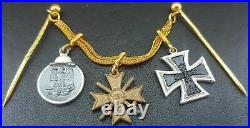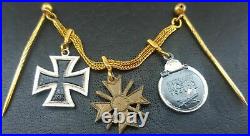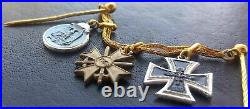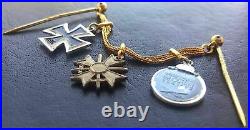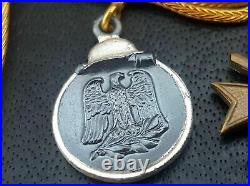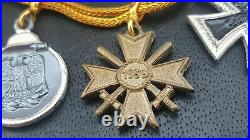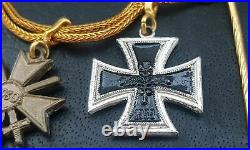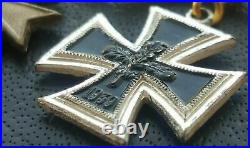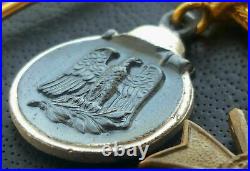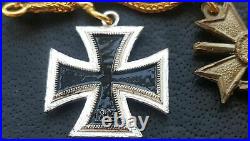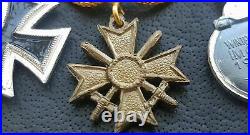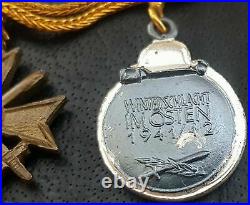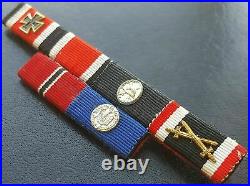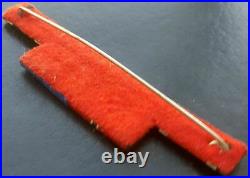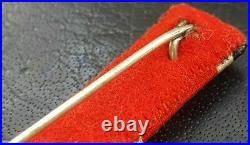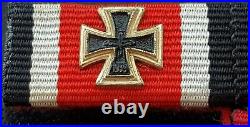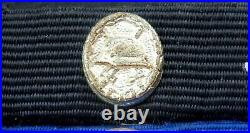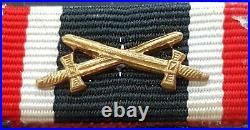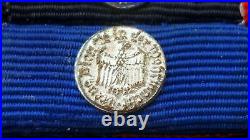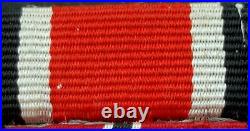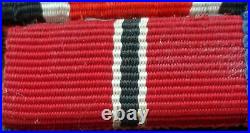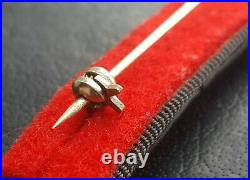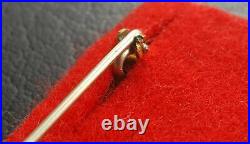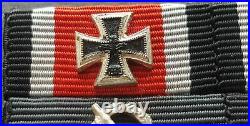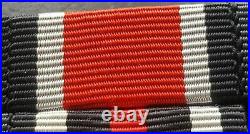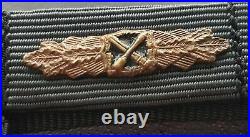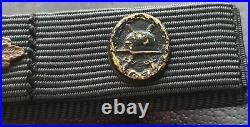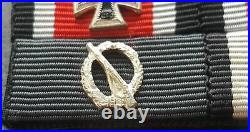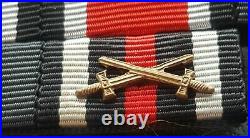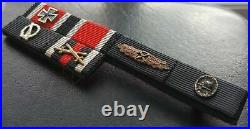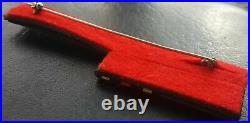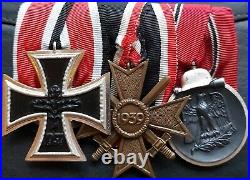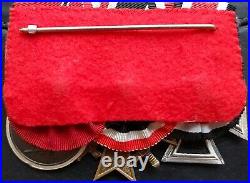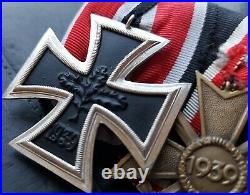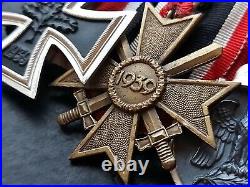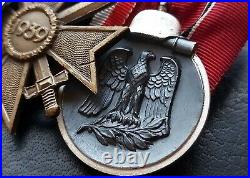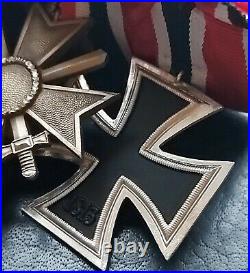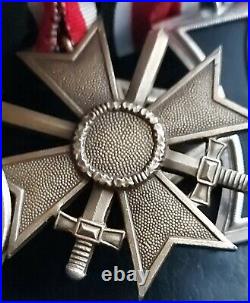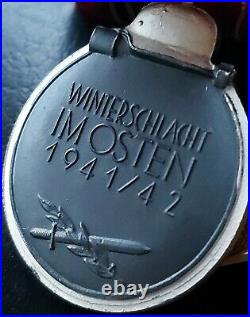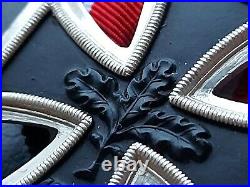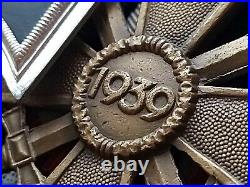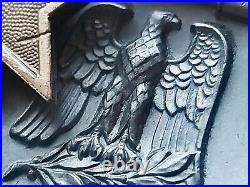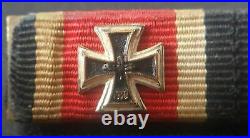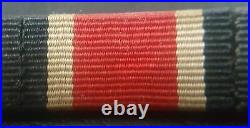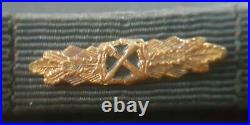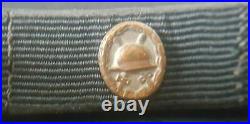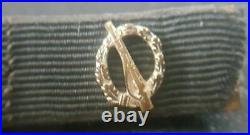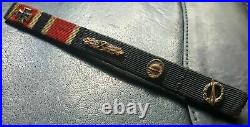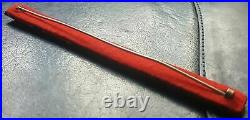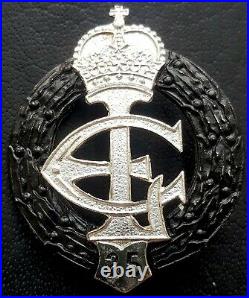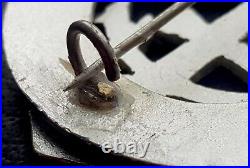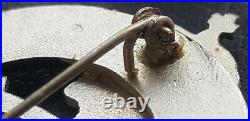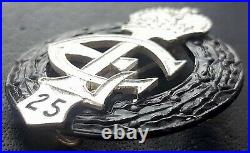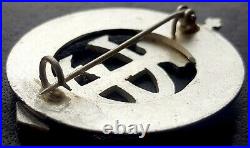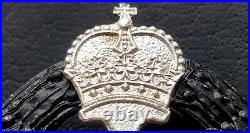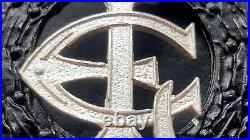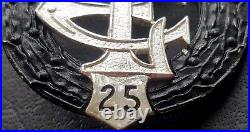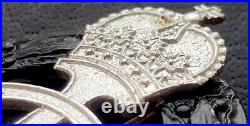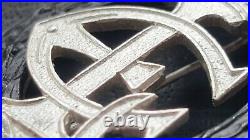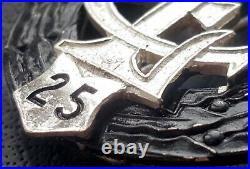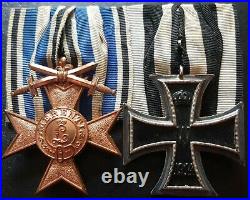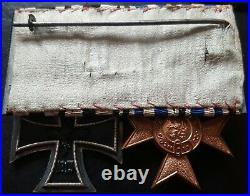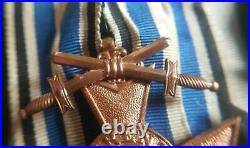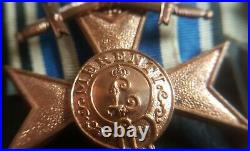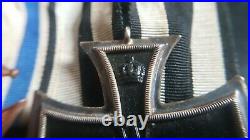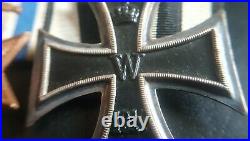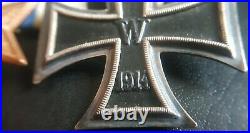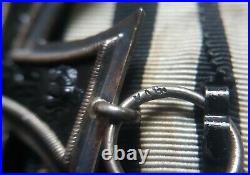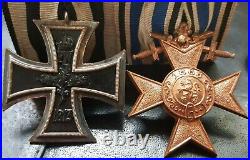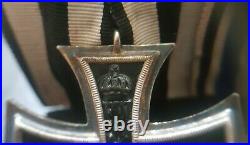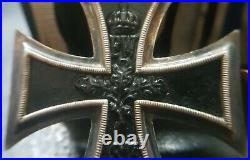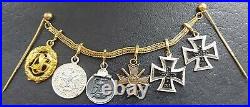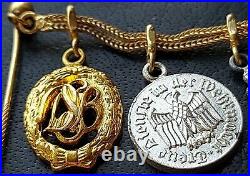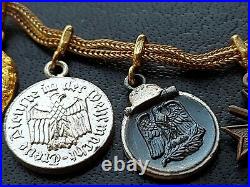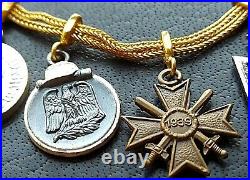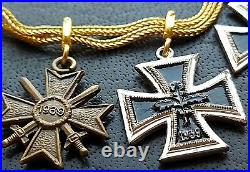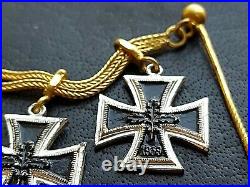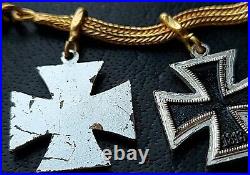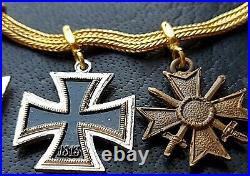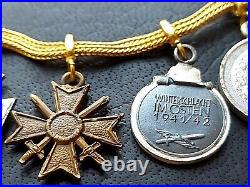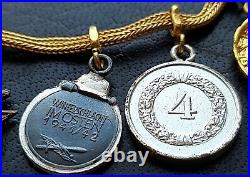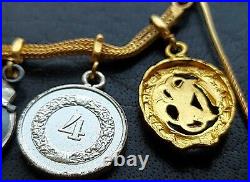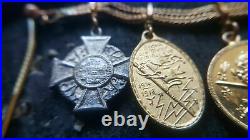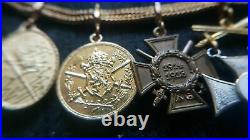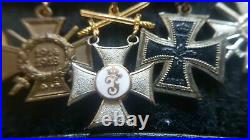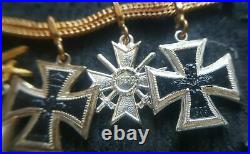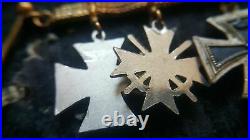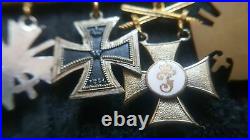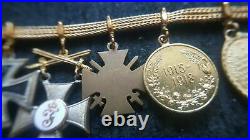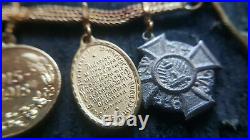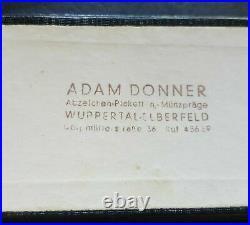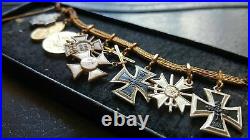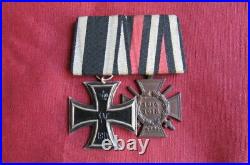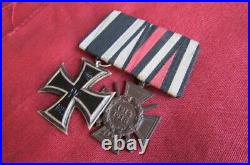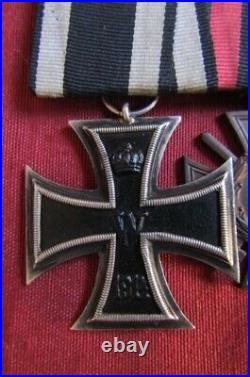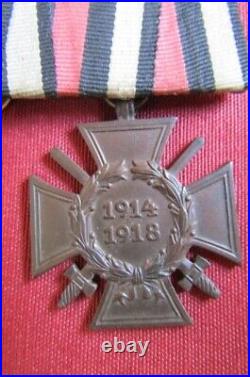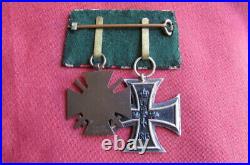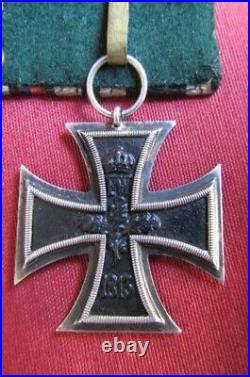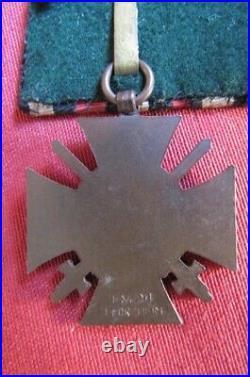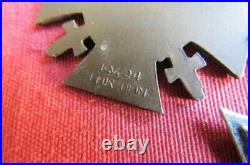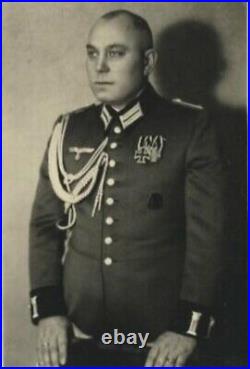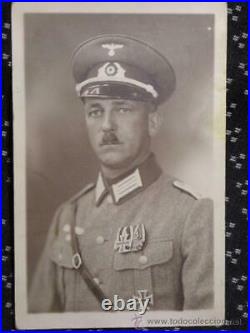Original German post WW2 (1957 pattern) WW1 & WW2 miniatures on chain: WW2 Iron Cross First Class, WW2 War Merit Cross With Swords First Class, WW1 Iron Cross II. Class, WW1 Friedrich Order Knight Cross With Swords II. Class, WW1 Honour Cross With Swords, WW1 Bulgarian War Commemorative Medal, WW1 Kyffhauser League War Commemorativa Medal & WW1 Kyffhauser League Service Cross II. Class, PERFECT CONDITION, GOOD DETAILED EXAMPLES, SIZES: cca 16 mm, VERY RARE COMBINATION OF AWARDS ON A VERY ATTRACTIVE CHAIN IN GENUINE CASE, MAKER MARKED: “ADAM DONNER – WUPPERTAL”. FEW FACTS ABOUT 1957 PATTERN AWARDS. In 1957 the West German government authorised replacement Iron Crosses with an Oak Leaf Cluster in place of the swastika, similar to the Iron Crosses of 1813, 1870, and 1914, which could be worn by World War II Iron Cross recipients. The 1957 law also authorised de-Nazified versions of most other World War II-era decorations (except those specifically associated with Nazi Party organizations, such as SS Long Service medals, or with the expansion of the German Reich, such as the medals for the annexation of Austria, the Sudetenland, and the Memel region). The main government contract to manufacture and supply these new de-nazified WW2 1957 official decorations went to the world famous German firm Steinhauer & Lueck, Luedenscheid Germany. Knights Crosses, Iron Crosses, Wound Badges, Tank Assault Badges etc were re-designed by Steinhauer & Lück – often with the oak-leaf spray replacing the swastika, with S&L having the sole patent rights to all WW2 1957 German decorations. S&L did not have the whole monopoly on medal making, other famous firms such as Deschler & Sohn, BH Maher and Juncker also manufactured these new German decorations. Lüdenscheid is situated between the cities Dortmund and Bonn. It was here that one of the youngest medal firms was founded in 1889 by August Steinhauer and Gustav Adolf Lück. The first production began in a cellar, the customer base continued to increase. A property was bought at 51 Hochstrasse which is still home for this famous company today. During WW2 Steinhauer & Lück produced medals and badges, like the famous Knights Cross and many other types of medals and badges. In 1957 this company was awarded the contract to produce all the newly re-designed legal WW2 1957 de-nazified decorations, plus the contract to manufacture all of Germany’s official decorations including Germany’s highest order the Bundesverdienstkreuz. Only a very limited number of original WW2 1957 medals are still produced, mainly Iron Crosses, German Cross Gold & Silver & Wound Badges and are considered 100% genuine by the German Government. HISTORY OF THE AWARD. Iron Cross (German: Eisernes Kreuz) was a military decoration of the Kingdom of Prussia, and later of Germany, which was established by King Friedrich Wilhelm III of Prussia and first awarded on 10 March 1813 in Breslau. In addition to during the Napoleonic Wars, the Iron Cross was awarded during the Franco-German War, the First World War, and the Second World War. The Iron Cross was normally a military decoration only, though there were instances of it being awarded to civilians for performing military functions. Two examples, the civilian pilot Hanna Reitsch was awarded the Iron Cross First Class for her bravery as a test pilot during the Second World War and Melitta Schenk Gräfin von Stauffenberg (also a German female test pilot) was awarded the Iron Cross Second Class. The Iron Cross was also used as the symbol of the German Army from 1871 to 1915, when it was replaced by a simpler Greek cross. In 1956, the Iron Cross became the symbol of the Bundeswehr, the German armed forces. The traditional design is black and this design is used on armored vehicles and aircraft. A newer design in blue and silver is used as the emblem in other contexts. The Iron Cross is a black four-pointed cross with white trim, with the arms widening towards the ends, similar to a cross pattée. It was designed by the neoclassical architect Karl Friedrich Schinkel and reflects the cross borne by the Teutonic Knights in the 14th century. The ribbon for the 1813, 1870 and 1914 Iron Cross (2nd Class) was black with two thin white bands, the colours of Prussia. The noncombatant version of this award had the same medal, but the black and white colours on the ribbon were reversed. Initially the Iron Cross was worn with the blank side out. This did not change until 1838 when the sprig facing could be presented. Since the Iron Cross was issued over several different periods of German history, it was annotated with the year indicating the era in which it was issued. For example, an Iron Cross from the First World War bears the year “1914″, while the same decoration from the Second World War is annotated “1939″. The reverse of the 1870, 1914 and 1939 series of Iron Crosses have the year “1813″ appearing on the lower arm, symbolizing the year the award was created. The 1813 decoration also has the initials “FW” for King Frederick William III, while the next two have a “W” for the respective kaisers, Wilhelm I and Wilhelm II. The final version shows a swastika. It was also possible for a holder of the 1914 Iron Cross to be awarded a second or higher grade of the 1939 Iron Cross. In such cases, a “1939 Clasp” (Spange) would be worn on the original 1914 Iron Cross. A similar award was made in 1914 but was quite rare, since there were few in service who held the 1870 Iron Cross. For the First Class award the Spange appears as an eagle with the date “1939″ that was pinned above the Cross. Although two separate awards, in some cases the holders soldered them together. A cross was the symbol of the Teutonic Knights (a heraldic cross pattée), and the cross design (but not the specific decoration) has been the symbol of Germany’s armed forces (now the Bundeswehr) since 1871. The Iron Cross was founded on 10 March 1813 in Breslau and awarded to soldiers during the Wars of Liberation against Napoleon. It was first awarded to Karl August Ferdinand von Borcke on 21 April 1813. King Wilhelm I of Prussia authorized further awards on 19 July 1870, during the Franco-German War. The Iron Cross was reauthorized by Emperor Wilhelm II on 5 August 1914, at the start of the First World War. During these three periods, the Iron Cross was an award of the Kingdom of Prussia, although given Prussia’s pre-eminent place in the German Empire formed in 1871, it tended to be treated as a generic German decoration. The 1813, 1870, and 1914 Iron Crosses had three grades: Iron Cross 2nd Class German: Eisernes Kreuz 2. Klasse, Iron Cross 1st Class German: Eisernes Kreuz 1. Klasse, Grand Cross of the Iron Cross (German: Großkreuz des Eisernen Kreuzes, often simply Großkreuz). Although the medals of each class were identical, the manner in which each was worn differed. Employing a pin or screw posts on the back of the medal, the Iron Cross First Class was worn on the left side of the recipient’s uniform. The Grand Cross and the Iron Cross Second Class were suspended from different ribbons. The Grand Cross was intended for senior generals of the German Army. An even higher decoration, the Star of the Grand Cross of the Iron Cross, was awarded only twice, to Field Marshal Gebhard von Blücher in 1813 and to Field Marshal Paul von Hindenburg in 1918. A third award was planned for the most successful German general during the Second World War, but was not made after the defeat of Germany in 1945. The Iron Cross 1st Class and the Iron Cross 2nd Class were awarded without regard to rank. One had to already possess the 2nd Class in order to receive the 1st Class (though in some cases both could be awarded simultaneously). The egalitarian nature of this award contrasted with those of most other German states (and indeed many other European monarchies), where military decorations were awarded based on the rank of the recipient. For example, Bavarian officers received various grades of that Kingdom’s Military Merit Order (Militär-Verdienstorden), while enlisted men received various grades of the Military Merit Cross (Militär-Verdienstkreuz). Prussia did have other orders and medals which were awarded on the basis of rank, and even though the Iron Cross was intended to be awarded without regard to rank, officers and NCOs were more likely to receive it than junior enlisted soldiers. In the First World War, approximately four million Iron Crosses of the lower grade (2nd Class) were issued, as well as around 145,000 of the higher grade (1st Class). Exact numbers of awards are not known, since the Prussian archives were destroyed during the Second World War. The multitude of awards reduced the status and reputation of the decoration. Among the holders of the 1914 Iron Cross 2nd Class and 1st Class was Adolf Hitler, who held the rank of Gefreiter. Hitler can be seen wearing the award on his left breast, as was standard, in many photographs. The straight-armed Balkenkreuz, the emblem of the Wehrmacht, first used in a narrower form on Luftstreitkräfte aircraft in mid-April 1918, and as shown here, as it appeared on German planes, tanks, and other vehicles during the Second World War. Adolf Hitler restored the Iron Cross in 1939 as a German decoration (rather than Prussian as in earlier versions), continuing the tradition of issuing it in various grades. Legally it is based on the enactment Reichsgesetzblatt I S. 1573 of 1 September 1939 Verordnung über die Erneuerung des Eisernen Kreuzes (Regulation for the Re-introduction of the Iron Cross). The Iron Cross of the Second World War was divided into three main series of decorations with an intermediate category, the Knight’s Cross, instituted between the lowest, the Iron Cross, and the highest, the Grand Cross. The Knight’s Cross replaced the Prussian Pour le Mérite or “Blue Max”. Hitler did not care for the Pour le Mérite, as it was a Prussian order that could be awarded only to officers. The ribbon of the medal (2nd class and Knight’s Cross) was different from the earlier Iron Crosses in that the color red was used in addition to the traditional black and white (black and white were the colours of Prussia, while black, white, and red were the colors of Germany). Hitler also created the War Merit Cross as a replacement for the non-combatant version of the Iron Cross. It also appeared on certain Nazi flags in the upper left corner. The edges were curved, like most original iron crosses. The standard 1939 Iron Cross was issued in the following two grades: Iron Cross 2nd Class Eisernes Kreuz 2. Klasse, Iron Cross 1st Class Eisernes Kreuz 1. Klasse abbreviated as EKI or E. The Iron Cross was awarded for bravery in battle as well as other military contributions in a battlefield environment. The Iron Cross 2nd Class came with a ribbon and was worn in one of two different methods: when in formal dress, the entire cross was worn mounted alone or as part of a medal bar, for everyday wear, only the ribbon was worn from the second hole in the tunic button. The Iron Cross First Class was a pin-on medal with no ribbon and was worn centered on a uniform breast pocket, either on dress uniforms or everyday outfit. It was a progressive award, with the second class having to be earned before the first class and so on for the higher degrees. It is estimated that some four and a half million Second Class Iron Crosses were awarded in the Second World War, and 300,000 of the First Class. The War Merit Cross (Kriegsverdienstkreuz) and War Merit Medal (Kriegsverdienstmedaille) was a decoration of Nazi Germany during the Second World War, which could be awarded to civilians as well as military personnel. It was reissued in 1957 by the Bundeswehr in a De-Nazified version for veterans. This award was created by Adolf Hitler in 1939 as a successor to the non-combatant Iron Cross which was used in earlier wars (same medal but with a different ribbon). The award was graded the same as the Iron Cross: War Merit Cross Second Class, War Merit Cross First Class, and Knights Cross of the War Merit Cross. The award had two variants: with swords given to soldiers for exceptional service in battle above and beyond the call of duty (but not worthy of an Iron Cross which was more a bravery award), and without swords for meritorious service behind the lines which could also be awarded to civilians. Recipients had to have the lower grade of the award before getting the next level. There was also another version below the 2nd class simply called the War Merit Medal (German: Kriegsverdienstmedaille), set up in 1940 for civilians in order to offset the large number of 2nd class without swords being awarded. It was usually given to those workers in factories who significantly exceeded work quotas. One notable winner of the War Merit Cross was William Joyce (aka Lord Haw-Haw) who received both the second and first class, both without swords. Recipients of the Knights Cross of the War Merit Cross customarily received the medal from holders of the Knights Cross of the Iron Cross, to symbolize the link between the combat soldier and their supporters, who helped maintain the war effort. There was one extra grade of the War Merit Cross, which was created at the suggestion of Albert Speer: The Knights Cross of the War Merit Cross in Gold, but this was never officially placed on the list of national awards as it came about in 1945 and there was no time to officially promulgate the award before the war ended. The Knights Cross of the War Merit Cross in Gold (without swords) was awarded’on paper’ to two recipients on 20 April 1945: Franz Hahne and Karl-Otto Saur. The ribbon of the War Merit Cross was in red-white-black-white-red; that was, the red and black colors being reversed from the ribbon of the World War II version of the Iron Cross. The ribbon for the War Merit Medal was similar, but with a narrow red vertical red strip in the center of the black field. Soldiers who earned the War Merit Cross 2nd Class with Swords wore a small crossed-swords device on the ribbon. The War Merit Cross 1st Class was a pin-backed medal worn on the pocket of the tunic (like the Iron Cross 1st Class). The ribbon of the War Merit Cross 2nd Class could be worn like the ribbon of the Iron Cross 2nd Class (through the third buttonhole). Combat soldiers tended to hold the War Merit Cross in low regard, referring to its wearers as being in’Iron Cross Training’, and prior to 28 September 1941, the War Merit Cross could not be worn with a corresponding grade of the Iron Cross, which took precedence. A total of 118 awards of the Knights Cross of the War Merit Cross with swords, and 137 awards of the Knights Cross of the War Merit Cross without swords were awarded. Considering the relative rarity of the award compared with the grades of the Knights Cross of the Iron Cross, it took on extra meaning. For example, Reichsmarschall Hermann Göring made a concerted effort to get Hitler to award him this order, much to Hitler’s annoyance. In response, Hitler outlined a series of criteria governing the awarding of this decoration and the philosophy of such awards, and directed that “prominent party comrades” were not to be awarded with the Knights Cross of the War Merit Cross (or similar decorations), and withdrew the proposed awards of this order to Gauleiter Erich Koch and State Secretary Karl Hanke. Directing his comments at Göring personally, Hitler ordered that such attempts to gain this award be stopped (from a letter dated 27 August 1943 from Führerhauptquartier). Also, the scarcity of the award of the Knights Cross of the War Merit Cross compared with the Kinghts Cross of the Iron Cross gave it an “air of exclusiveness” it did not really deserve, as it ranked below the Knights Cross of the Iron Cross. Six persons received two Knights Cross’ of the War Merit Cross (one with Swords and one without Swords): Walter Brugmann, Julius Dorpmuller, Karl-Otto Saur, Albin Sawatzki, Walter Schreiber, and Walter Rohlandt. The Friedrich Order (German: Friedrichs-Orden or Friedrichsorden) was an order of merit of the German Kingdom of Württemberg. It was instituted on 1 January 1830 by the second king of Württemberg, Wilhelm I in remembrance of his father, King Friedrich I. In 1918, the end of the monarchy meant the abolition of the order. The order was created with a single class, conferring nobility. On 3 January 1856, the Order was recreated with four classes were created and on 29 September 1870 a Knight 1st Class and a military division with swords were added (existing Knights were appointed Knights 1st Class). In 1892 the “Medal of the Order of Frederick” was added to the order. An additional rank was created on 6 March 1899, the Grand Cross with Crown (or Crown of the Grand Cross). The classes were: Grand Cross with Crown, Grand Cross, Commander 1st Class, Commander 2nd Class, Knight Ist Class, Knight 2nd Class. The ribbon was skyblue. Cross of Honour, also known as the Honour Cross or, popularly, the Hindenburg Cross, was a commemorative medal inaugurated on July 13, 1934 by Reichspräsident Paul von Hindenburg for those soldiers of Imperial Germany who fought in World War I. It came in three versions: Honour Cross for Combatants (Ehrenkreuz für Frontkämpfer) – for soldiers who fought on the front, Honour Cross for War Participants (Ehrenkreuz für Kriegsteilnehmer) – for non-combatant soldiers, Honour Cross for Next-of-Kin (Ehrenkreuz für Hinterbliebene) – for the next-of-kin of fallen soldiers. After the annexation (Anschluss) of Austria in 1938, Austrian veterans of World War I were also eligible for the Cross of Honour. A total of 6,250,000 Crosses were awarded to combatants, 1,200,000 were awarded to non-combatants and 720,000 medals were awarded to next-of-kin. A variation with an anchor in the center, and referred to as the Naval Cross, was issued to veterans of the Imperial German Navy. The Honour Cross for War Participants differed from the Honour Cross for Combatants by not having the crossed swords. The Honour Cross for Next-of-Kin also lacked swords, was lacquered in black, and had a different ribbon. The medal is suspended from a ribbon with a thin black lines of its sides, a red line in the center and next to it a black and white lines on each side, on the next-of-kin medal the ribbon colors are reverse. The medal is 3.6mm thick and thus of Swiss manufacture. The medal was created by decree on 9 December 1933 and awarded to all participants then living in World War I, both military and civilian, until 31 December 1939. The medal could be awarded to military from the Central Powers and to foreign citizens; in the event the largest such group was German military. Bulgaria felt a great sense of grievance following the loss of territory at the conclusion of the second Balkan War in 1913. When Germany offered to restore all of the lands she had been promised in 1878, Bulgaria, which had the largest army in the Balkans, declared war on Serbia in October 1915. In return, Britain, France and Italy then declared war on Bulgaria. After initial victories, the war became unpopular because of food and other shortages and the revolution in Russia in 1917 had a profound effect on Bulgarian sentiment. When the Allies finally broke out of the Salonika pocket, Bulgaria sued for peace and King Ferdinand I abdicated in favour of his son who became King Boris III. The Treaty of Neuilly that concluded the war took significant territory from Bulgaria and imposed severe restrictions on the future size of her armed forces. The medal was instituted in 1922 and, until the issue of the Cross of Honour of the World War (Ehrenkreuz des Weltkrieges), better known as the’Hindenburg Cross’ in 1934, was often the only medal of the German soldiers of World War I. The Kyffhäuserbund der Deutschen Landeskriegerverbände veterans’ organisation was set up some years before World War I and Field Marshal Paul von Beneckendorff und von Hindenburg was its President of Honour during the 1920s. After his death in 1934, the medal was amended by the National Socialist government with the addition of a cross gammée (Hackenkreuz or swastika). After WWI, a variety of German veteran organization sprang up across the country, keeping with a long-established tradition. One of these was the “Kyffhäuserbund” (Kyffhäuser Veteran’s Organization) who issued a brass type oval medal to commemorate service in WWI. For many veterans, this was the only WWI service medal that was worn until the German Cross of Honor (“Ehrenkreuz”) was officially established in 1934. After the Cross of Honor was authorized, many veterans continued wearing their unofficial medals so it is not uncommon to find this with an official medal grouping – usually worn on civilian clothes, band uniforms, etc. Obviously, if they were wearing their medals in official uniform, the medal wasn’t allowed. It’s interesting to note that many – if not most – of the organizations allowed veterans of the 1870-71 Franco-Prussian War to join – normally as honorary members – and allowed them to wear the organization’s medals. On 2 May 1931, possibly the last Franco-Prussian War veteran joined. The main trivia point being that a Kyffhäuserbund Medal with a Franco-Prussian War Medal and 1897 Centenary Medal is unusual but certainly not impossible and does not indicate service in WWI. This very low cost medal is fairly well documented and illustrated on the internet. What generally isn’t illustrated is the numerous devices or attachments that might be found with it but not necessarily. Each organization had a list of devices available and the veteran could make his own selection from that list, at an additional cost. The most common device found is the crossed swords (which indicate a combatant). Absence of the crossed swords does not necessarily mean that the recipient was a non-combatant, just that they are not on the ribbon. The medal is sometimes found with a laurel wreath supporting a diagonal sword (which usually indicates a naval combatant recipient – but it was the buyers decision). Other attachments are the various battle bars which closely resemble those found on the Franco-Prussian War Medal. Other battle bars are available and have almost every German battle listed. The most bars I’ve seen attached to one medal was 7 but this one appeared to be a “made-up” grouping of bars. The rarest bars would possibly be ones for Africa (no originals are currently known). I’ve never seen a “country” bar – only battle associated. The impressed names on the bars are usually filled in with black enamel. Most devices use a double prong back attachment although one series of the battle bars are the “slide-on” type and are large enough for a double-wrap ribbon. Kyffhäuser Cross of Merit (Kyffhäuser-Verdienst-Kreuz) by H. Timm of Berlin – Large silvered metal cross pattée with panelled arms, with the initials’PLKV’ (for Preussischer Landes Kriegern Verband = Prussian State Veterans Association) between the arms, with loop for ribbon suspension bearing maker’s mark’ BERLIN’; the face with a circular central medallion bearing the radiant Kyffhäuserdenkmal (Kyffhäuser Monument); the reverse with a circular central medallion inscribed in Gothic script’Für Verdienst im Kriegervereins Wesen’ (for Merit in War Veterans Association); diameter cca 44 mm. The Cross was instituted after World War I to recognise meritorious service in the Preußischer Landes Kriegern Verband, equivalent of the British and American Legions, in its philanthropic, charitable and social work. This item is in the category “Collectables\Militaria\World War II (1939-1945)\Medals/ Ribbons”. The seller is “a..anderson” and is located in this country: GB. This item can be shipped worldwide.
- Era: 1945-Present
- Country/ Organization: Germany
- Country/Region of Manufacture: Germany
- Theme: Militaria
- Service: Army
- Conflict: World War II (1939-1945)
- Type: Medals & Ribbons
